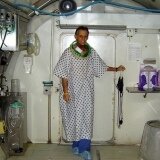Necrotizing Soft Tissue Infections And HBOT

Necrotizing soft tissue infections comprise several categories of diseases that are characterized by rapidly progressive extensive soft tissue necrosis which usually affects a muscular fascia and subcutaneous tissue, but can also affect the skin and muscle.
Based on the soft tissue layer affected by necrosis, soft tissue infections can be classified as fasciitis, cellulitis and myositis.257, 258
Necrotizing wound infection may result from either a single strain or a mixed population of bacteria, typically occurring after trauma, surgery, and/or around foreign bodies.
The individual affected by such infections is frequently compromised by conditions such as diabetes or vascular disease.
Names of the clinical syndromes comrising soft tissue Infections include crepitant anaerobic cellulitis, progressive bacterial gangrene, necrotizing fasciitis, and nonclostridial myonecrosis. Gas gangrene (Clostridial Myositis and Clostridial Myonecrosis) is a separate entity and is discussed on this site.
©2008 Undersea and Hyperbaric Medical Society, Inc. The book can be purchased at UHMS web site.
By Michael Lepawsky, B.A., M.D., CCFP(C), FCFP
Hyperbaric Oxygen Therapy is an accepted adjunct to surgical and antibiotic treatment for necrotizing soft tissue infections. Such conditions may result from a single or a mixed population of organisms. They may be aerobic or anaerobic. Some necrotizing infections appear to be the result of a synergistic combination of organisms. Such infections appear in a wide variety of clinical settings, particularly after trauma, surgical wounding, and/or around foreign bodies.
The host is frequently compromised in some way, often with diabetes, vasculopathy, or both. Infections typically cause local tissue hypoxia and, in the case of necro infections, this is exacerbated by an infection-induced occlusive endarteritis. Additionally, both toxin effect and intravascular sequestration of leukocytes occur in the presence of certain organisms associated with necrotizing soft tissue infections, resulting in a paucity of polymorphonuclear leukocytes (PMNs) neutrophils at the site of infection.
Hypoxic conditions profoundly impair PMN function. As a local infection develops, metabolism by facultative organisms further depletes the oxygen that is available. This action, as well as the accumulation of metabolic products, lowers the oxidation-reduction potential (Eh). Conditions are thereby improved for the growth of anaerobic bacteria. Metabolism by the mixed aerobic and anaerobic flora decreases the Eh and tissue oxygen levels further and the infectious process accelerates. These changes serve to promote the growth of even more fastidious organisms.
Discernible quantities of tissue gas may be produced in many mixed flora infections. Although carbon dioxide (CO2) is one of the end products of aerobic metabolism, it is readily dissipated and cleared by the body, rarely accumulating in tissues. Incomplete oxidation of substrates by facultative and anaerobic bacteria can result in the production of less soluble gases such as H2, H2S, and CH4, which do accumulate in tissues. The presence of these gases indicates rapid bacterial multiplication at a low Eh.
The principal treatments for necrotizing soft tissue infections are surgical debridement and administrations of systemic antibiotics. Hyperbaric oxygen (HBO2) is recommended as an adjunct only in those settings where mortality and morbidity are expected to be high despite aggressive standard treatment. HBO2 has been used in the past because of its anticipated benefits in abating the synergistic interaction present in mixed infections.
The improved tissue oxygen tension will adversely affect anaerobic bacterial growth by direct toxic mechanisms, as well as by increasing tissue Eh. Investigators have also shown that obligate anaerobic bacteria can inhibit PMN phagocytosis of facultative organisms.
Hyperbaric oxygen should also ameliorate these effects since improved oxygenation can improve PMN function and bacterial clearance. It has recently been suggested that the rapidity of Streptococcal and Clostridial tissue necrosis was the consequence of leukocyte-endothelial interactions, leading to progressive vascular insufficiency and ischemic necrosis. Bryant and co-workers have demonstrated that Clostridial theta toxin and streptolycin O, nearly identical thiol-activated cytolysins, up-regulate endothelial adherence molecules (E-selectin, platelet activating factor, and ICAM-1) as well as the granulocyte adherence molecule CD18b/CD18.
In vitro, this interaction results in adherence of PMNs to endothelium and after, several hours, cytotoxicity of endothelial cell monolayers. HBO2 has been shown to decrease neutrophil adherence by selective inhibition of beta-2 integrin function, preventing persistent PMN adherence to the endothelium in a carbon monoxide injury model. Additional work is needed to demonstrate a similar mechanism action in necrotizing wounds.
The primary treatments for soft tissue infection or wound infection are surgical excision of infected tissue and administration of appropriate antibiotics. In selected cases, addition of hyperbaric oxygen therapy may be both lifesaving and cost effective. Hyperbaric oxygen may be beneficial in several ways. Some of the bacteria involved in soft tissue infections are anaerobic, growing most rapidly in a low oxygen environment. In the hyperbaric chamber, tissue oxygen levels may be raised sufficiently to inhibit bacterial growth. In addition, hyperbaric oxygen treatment may enhance the ability of neutrophils to kill bacteria, by a number of different mechanisms.
The use of hyperbaric oxygen for treatment of necrotizing soft tissue infections should be individualized. In specific instances where risk of morbidity and mortality are high, adjunct hyperbaric oxygen therapy should be considered.












